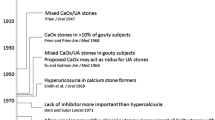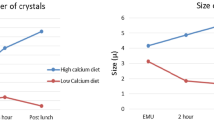Summary
A retrospective study was done on the nature and degree of crystalluria in fasting and postprandial urine in patients with recurrent idiopathic calcium urolithiasis (RCU) for whom stone analysis was available. RCU was stratified into subgroups in accordance with stone analysis. The crystals were obtained and identified using a filter technique and polarization microscopy, respectively. Crystalluria score, relative saturation products (RSPs), and low-molecular-weight inhibitors were assessed. Calcium oxalate crystals were never observed in either male or female patients with stones composed exclusively of calcium oxalate, and only sporadically in patients with mixed stones (the additional component was calcium phosphate in most cases). Other crystalluria phases, such as amorphous calcium phosphate, a urate-containing phase, and a phase presenting as spherolytic particles, were slightly more frequent in patients with mixed stones. In contrast to crystalluria, RSPs and inhibitors differed in male and female patients, suggesting that crystalluria may not be under the exclusive control of these factors. The following conclusions were reached. (1) Calcium oxalate crystalluria is absent from RCU with pure calcium oxalate stones; hence, calcium oxalate crystalluria does not qualify as a diagnostic aid. (2) The co-existence of the isotropic phase and mixed stones may indicate that the formation of these concretions is characteristic for a major RCU subgroup. (3) On the basis of clinical chemistry and physicochemical data in urine and of crystalluria, it appears that the pathogenesis of RCU differs in male and female subjects.
Similar content being viewed by others
References
Boyce WH (1968) Organic matrix of human urinary concretions. Am J Med 45:673
Brown BL, Ekins RP, Albano JDM (1972) Saturation assay for cyclic AMP using endogenous binding protein. Adv Cycl Nucl Res 2:25
Burns JR, Finlayson B, Gauthier J (1984) Calcium oxalate retention in subjects with crystalluria. In: Ryall RL, Brockis JG, Marshall VR, Finlayson B (eds) Urinary stone. Proceedings of the Second International Urinary Stone Conference, Singapore 1983. Churchill Livingstone, Melbourne Edinburgh London New York, p 253
Cheung CP, Suhadolnik RJ (1977) Analysis of inorganic pyrophosphate at the picomole level. Anal Biochem 83:61
Dahlberg CJ, Kurzt SB, Wilson DM, Smith LH (1977) Clinical features and management of crystinuria. Mayo Clin Proc 52:533
Fazil Marickar YM, Sachidev K, Joseph T, Sindhu S, Vathsala R (1989) The relative merits of early morning vs random urine samples for studying crystalluria. In: Walker VR, Sutton RAL, Cameron ECB, Pak CYC, Robertson WG (eds) Urolithiasis. Plenum Press, New York London, p 41
Finlayson B (1974) Renal lithiasis in review. Urol Clin North Am 1:181
Fleisch H (1978) Inhibitors and promoters of stone formation. Kidney Int 13:344
Gault MH, Parfrey PS, Robertson WG (1988) Idiopathic calcium phosphate nephrolithiasis. Nephron 48:265
George A, Sachidev K, Joseph T, Vathsala R, Fazil Marickar YM (1989) Histochemistry of urinary deposits. In: Walker VR, Sutton RAL, Cameron ECB, Pak CYC, Robertson WG (eds) Urolithiasis, Plenum Press, New York London, p 33
Herrmann U, Schwille PO, Kuch P (1991) Crystalluria determined by polarization microscopy — technique and results in healthy control subjects and patients with idiopathic recurrent calcium urolithiasis classified in accordance with calciuria. Urol Res 19:151
Hesse A, Bach D (1982) Harnsteine. Pathobiochemie und klinisch-chemische Diagnostik. Thieme, Stuttgart New York, p 243
Kageyama N (1971) A direct colorimetric determination of uric acid in serum and urine with uricase catalase system. Clin Chim Acta 31:421
Khan SR, Shevock PN, Hackett RL (1988) Lipids of calcium-oxalate urinary stones. In: Walker VR, Sutton RAL, Cameron ECB (eds) Urolithiasis. Plenum Press, New York London, p 125
Khan SR, Shevock PN, Hackett RL (1988) In vitro precipitation of calcium oxalate in the presence of whole matrix of lipid components of the urinary stones. J Urol 139:418
Marshall RW, Robertson WG (1976) Nomograms for the estimation of the saturation of urine with calcium oxalate, calcium phosphate, magnesium ammonium phosphate, uric acid, sodium acid urate, ammonium acid urate and cystine. Clin Chim Acta 72:253
Miller RG (1966) Simultaneous statistical inference. McGraw-Hill, New York
Moellering H, Gruber W (1966) Determination of citrate with citrate lyase. Anal Biochem 17:369
Robertson WG, Peacock M (1972) Calcium oxalate crystalluria and inhibitors of crystallization in recurrent renal stone formers. Clin Sci 43:499
Robertson WG, Peacock M, Nordin BEC (1969) Calcium crystalluria in recurrent renal stone formers. Lancet II:21
Robertson WG, Scurr DS, Bridge M (1981) Factors influencing the crystallisation of calcium oxalate in urine-critique. J Cryst Growth 53:182
Rushton HG, Spector M, Rodgers AL, Magura CE (1980) Crystal deposition in the renal tubules of hyperoxaluric and hypermagnesemic rats. Scanning Electron Microsc 3:387
Scholz D, Schwille PO (1981) Klinische Laboratoriumsdiagnostik der Urolithiasis. Dtsch med Wochenschr 106:229
Scholz D, Schwille PO, Ulbrich D, Bausch WM, Sigel A (1979) Composition of renal stones and their frequency in a stone clinic: relationship to parameters of mineral metabolism in serum and urine. Urol Res 7:161
Schwille PO, Manoharan M, Rümenapf G, Wölfel G, Berens H (1989) Oxalate measurement in the picomol range by ion chromatography: values in fasting plasma and urine of controls and patients with idiopathic calcium urolithiasis. J Clin Chem Clin Biochem 27:87
Smith LH (1978) Calcium containing renal stones. Kidney Int 13:383
Werness PG, Bergert JH, Smith LH (1981) Crystalluria. J Cryst Growth 53:166
Winkens RAG, Wielders JPM, van Hoof JP (1988) Calcium oxalate crystalluria, a curiosity or a diagnostical aid? (Letter to the editor). J Clin Chem Clin Biochem 26:653
Author information
Authors and Affiliations
Rights and permissions
About this article
Cite this article
Herrmann, U., Schwille, P.O. Crystalluria in idiopathic recurrent calcium urolithiasis. Urol. Res. 20, 157–164 (1992). https://doi.org/10.1007/BF00296529
Accepted:
Issue Date:
DOI: https://doi.org/10.1007/BF00296529




